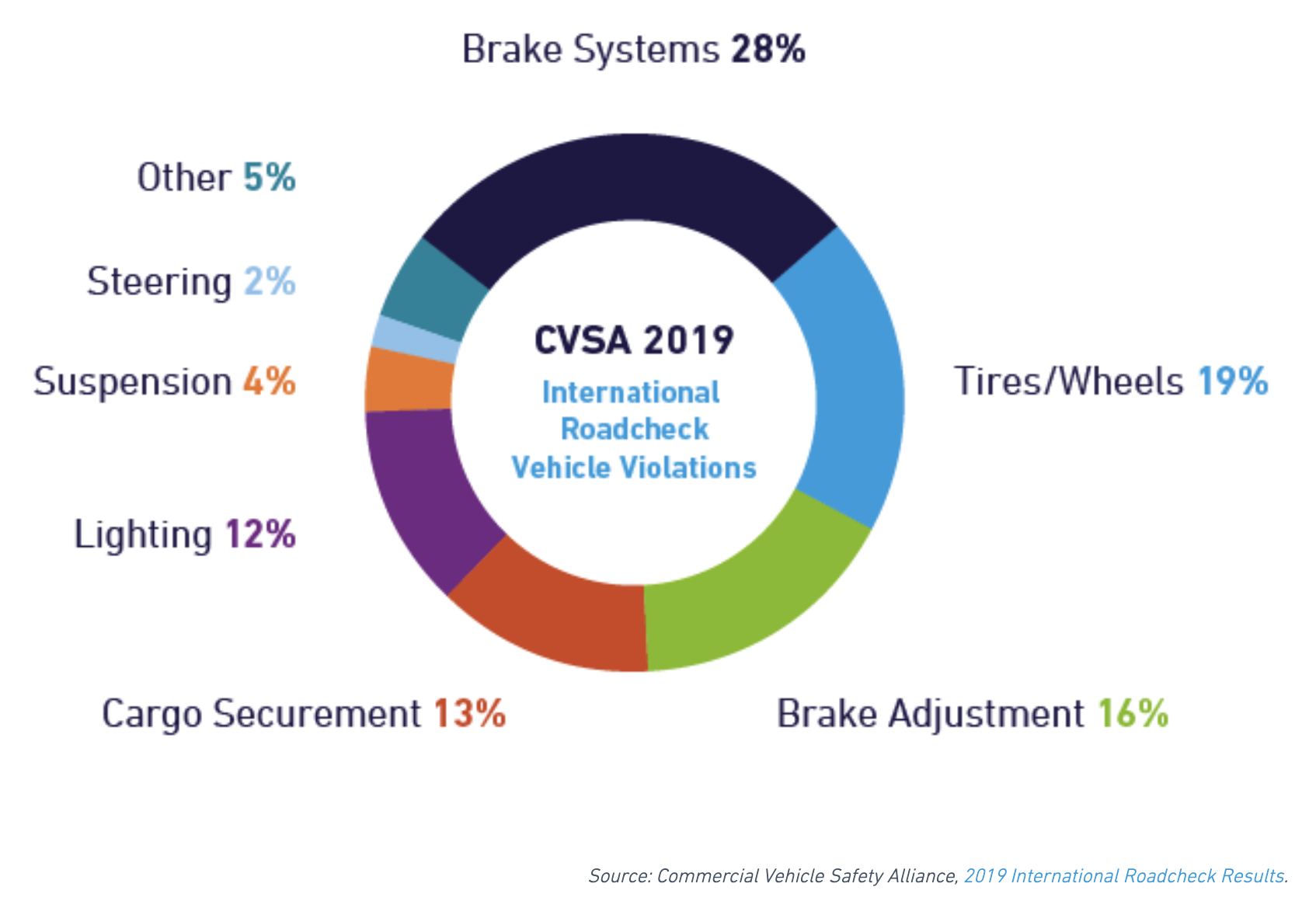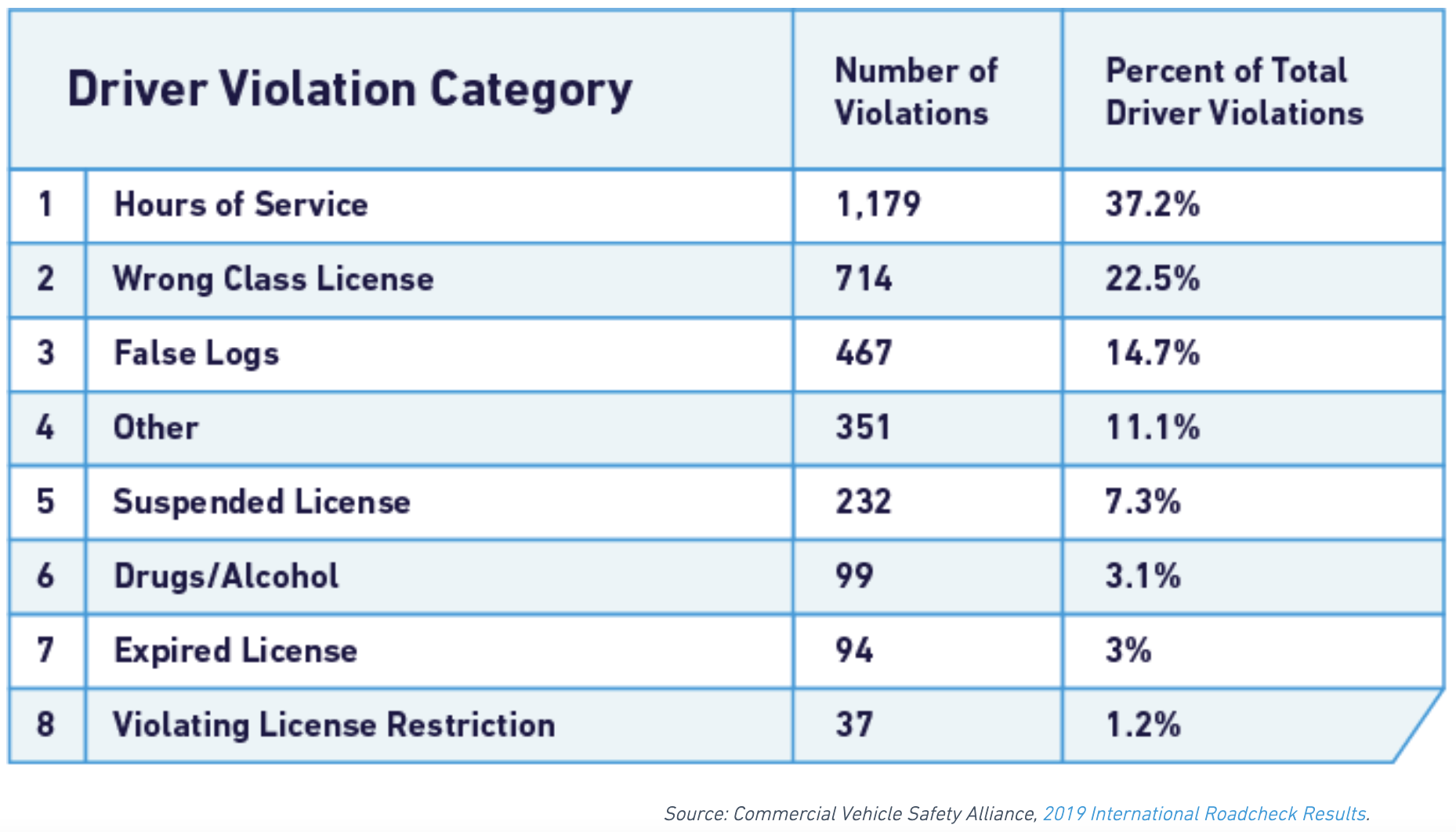CVSA Roadcheck 2019: Results and Recommendations

Recently, the Commercial Vehicle Safety Alliance (CVSA) released results from its 2019 International Roadcheck.
As in prior years, this annual inspection led to a substantial number of vehicles being taken off the road, as well as thousands of drivers temporarily taken out of service. In total, 67,072 commercial motor vehicles and drivers in Canada and the U.S. were inspected between June 4 and June 6, 2019. Of those vehicles, 12,019 (17.9 percent) were removed from roadways for critical violations, down from 21.6 percent last year. In addition, 2,784 drivers, or 4.2 percent of those inspected, were taken out of service, up slightly from 3.9 percent in 2018.
This year’s vehicle inspections focused on steering and suspension systems, but as always, the inspections were both broad and deep, examining the fitness of both drivers and vehicles in great detail. The results, and their consequences, highlight how DOT compliance and other safety issues are identified–and how you can make sure your drivers and vehicles are ready for any inspection.
Here’s a breakdown of the top vehicle violations for this year’s CVSA Roadcheck:

Among drivers, the top driver violations were for hours of service (HOS), followed by wrong class license, and false logs. Here’s a snapshot of the top driver-related violations for 2019:

Similar to 2018, hours of service accounted for more than a third of all driver violations. The ELD mandate that went into effect in 2018 has placed additional scrutiny on HOS compliance. HOS violations generally relate to exceeding operating limits, falsifying logs, or failing to keep proper record of duty status. The ELD mandate requires the use of electronic logging devices (ELDs) to log HOS in commercial motor vehicles involved in interstate commerce when operated by drivers who are required to keep hours-of-service records of duty status. Electronic logging devices can help drivers stay compliant by letting them know when they have driven too many hours in a given day or week.
There were also 748 seatbelt violations, compared to 729 in 2018, highlighting the recurring nature of the challenge among drivers. According to FMCSA’s latest Seat Belt Usage by Commercial Motor Vehicle Drivers Survey, seat belt compliance among drivers of medium- and heavy-duty trucks and motor coaches was only 86% in 2016. Video telematics systems can help monitor seatbelt usage and other driver behaviors to keep fleets safer.
What’s at stake
Vehicle and driver violations can have serious consequences. If an inspector identifies a critical equipment issue, the vehicle will be taken out of service until the defect is corrected. The same is true of driver-related conditions as described in the CVSA North American Standard Out-of-Service Criteria: a driver in violation will be taken out of service until the condition can be rectified.
A vehicle or driver violation can mean that any freight on the vehicle won’t be delivered until a replacement driver, vehicle, or trailer can be brought to the scene. If the vehicle can’t be driven as-is, the carrier might need to send a repair truck. If the problem is with the driver, the carrier might need to hire a fill-in driver to complete the delivery. These problems can seriously impact short-term productivity—but it gets even worse when you consider how the number of out-of-service orders or safety violations affect a motor carrier’s Compliance, Safety, Accountability (CSA) score and its Safety Fitness Determination (SFD) rating.
Getting caught by surprise with an inspection can affect not only the delivery or cargo shipment in progress, but can also have long-term consequences. By affecting CSA and SFD ratings, adverse inspections can ultimately affect the rates the carrier can charge and whether companies will do business with them.
Proactive DOT compliance is the answer
If you take away one thing from the CVSA Roadcheck 2019 results, it should be that compliance with DOT requirements is a year-round practice, and that safety is about more than just the CVSA inspection checklist. If you know your drivers and vehicles are in compliance, you won’t have to worry about becoming part of the statistics next year.
One good way to proactively identify and rectify areas of improvement is with Lytx Compliance Services, which provide all the information you need to make sure your drivers and vehicles are operating properly.
The Lytx HOS tracking system audits all driver logs and supporting documents, regardless of format, to help you ensure compliance under the ELD compliance mandate. We compile your datasets, providing a single, online source of truth to help track driver HOS compliance. Lytx Compliance Services integrate with virtually every major ELD to consume and audit log data – perfect for fleets with multiple ELD providers.
Lytx has the added capability to validate electronic and paper logs with events and supporting documentation against the driver’s duty status. These log falsification checks are validated using data from fuel cards, GPS, E-ZPass, roadside inspections, accidents, and more. The result is a comprehensive audit of 100 percent of driver logs, with a precise analysis of documentation gaps and flags for falsified, incomplete or inaccurate logs.
In other words, with Lytx, you have the oversight to detect when drivers have HOS violations or falsify logs so that you can take required action before the driver’s problems become your problems. This includes DQ File Management to determine if any of your drivers have the wrong class license or if any have an expired or suspended license. When you have the ability to audit driver qualification files you know what each driver is authorized to do and you can make sure their credentials are up to date.
Another important but time-consuming process is the management of Driver Vehicle Inspect Reports (DVIRs). Lytx Compliance Services help you streamline DVIR management, saving you time while increasing your compliance with Federal Motor Carrier Safety Association (FMCSA) regulations. Most CSA violations fall under the Vehicle Maintenance Behavior Analysis and Safety Improvement Category (BASIC). Lytx’s CSA Data Analysis helps you identify drivers who haven’t completed vehicle inspection reports so you can reduce avoidable violations, fines, out of service times, and maintenance costs.
Once you have ensured that each vehicle is properly maintained and every driver’s documentation is in order, it is equally important to be aware of how your drivers perform on the road—driver behavior contributes to 94% of all traffic crashes. The Operation Safe Driver Week enforcement initiative is the commercial motor vehicle (CMV) law enforcement community’s response to this transportation safety issue. Through this initiative, law enforcement personnel aim to deter negative driver behaviors and reduce the number of crashes involving large trucks, motor coaches and passenger vehicles. During the most recent Operation Safe Driver Week in July, officers issued 46,752 citations and 87,624 warnings to drivers for traffic enforcement violations, ranging from speeding to failure to wear a seatbelt.
Lytx can help
As you can see, your best strategy is to know that you’re in compliance before it becomes an issue. From managing equipment condition and driver reports to helping drivers improve their behavior, Lytx can help you operate more safely and cost effectively while you improve your fleet’s BASIC and CSA scores.
Contact sales to discuss how our compliance services can help you improve your fleet.
